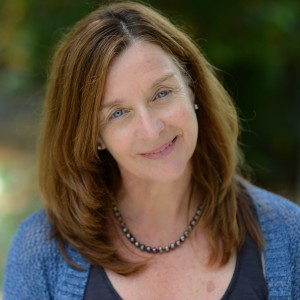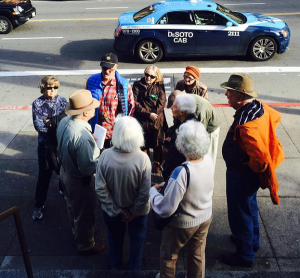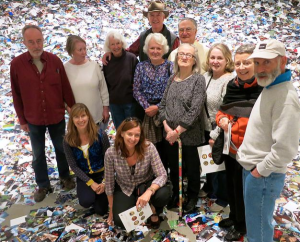Today SevenPonds speaks with Patricia Ris, the program director and founder of Memory Care Cafe. Her San Francisco-based program teaches people with Alzheimer’s how to stay involved in their communities and maintain an active lifestyle. The group focuses on people in the early stages of the disease, with special attention given to caregivers of those who have Alzheimer’s.
Marissa: What made you want to start Memory Care Cafe?
Patricia: I worked in this type of service for seniors since the beginning of 2000. I realized there was a lot that wasn’t being done. There was some being done, but there was a lot of, let’s say, neglect around people who live in communities for Alzheimer’s. I felt that there were assumptions being made or thoughts not complete around what their needs were.
As I progressed in my career providing services, ending as an enrichment director in a larger community, I realized there’s a huge amount of desire and willingness and enthusiasm for activities. When I ended working there, I spent time with my mother in the Netherlands who is physically disabled, and I saw her mental awareness declining as well. I realized she had this willingness to go out. It was really hard for her, even in the Netherlands, to go out and do what she wanted to do because of her physical limitations.
So when I came back after an extended period, I realized that what I really wanted to do is fill that gap for a very specific demographic who live at home, who have a care partner (very often their spouses) and who need to be integrated into society. And I think at the same time that society needs to welcome this type of population in a more sustained way. It seems really complicated, but it’s really simple. I felt that there was a need that was not being met, and I had a lot of sympathy, and so I decided to create an activity program, a life enrichment program, for people who live at home.
Marissa: So your program fills a niche for this specific group. Do you focus mainly on people who live at home 24/7, who maybe aren’t as forgetful as people in later stages of the disease?
Patricia: We have a varied group. Yes, it does start out with people who live at home. I think it is a very heavy caregiving job for spouses who live with their loved one who has progressive cognitive decline. But they do cope. Some people are still very sick, and we’re seeing a very small selection of the population [in our group]. They have to be fit; they have to be accompanied by a professional caregiver or spouse – we don’t take people individually except with some exceptions. They have to want to engage in the outdoors and in larger settings.
Marissa: What sort of activities do you do with people in the group?
Patricia: We became what we are because of the energy of the group. So I have programmed very much with the desire of what the people wish, and going with the fact that this is a very outdoorsy group. Several of our participants use public transportation. They love to figure out how to get to a place; they love to discover the city. So we typically meet in different locations in the city. We announce where we are going to be on our website, and we tell a little bit more about what we’re going to do in our newsletter.
Every week, I set up detailed mail about what we’re going to do, where we’re going to be, how to get there, suggestions for parking and public transportation, what kind of clothing to wear and what to expect with the activity itself. We do neighborhoods. We go outdoors as much as we can. Fortunately, the weather has been amazing. So we’re outdoors a lot. We go to museums, and once a month we meet each other at the gatehouse at Fort Mason. It was originally our desire to have a permanent location, but our current membership isn’t rapid enough to warrant that type of expense.
This past Monday, we created a terrarium. I brought all of the materials to make a mini garden, and after we finished that activity we had someone come and sing songs with us. In April, we’ll have a health and wellness coach, someone who can do exercises and who has a very fun personality. It feels like we’re working out, but we’re really learning about caring for the body. Sometimes we go out and we play a ball game, and then we go back and socialize. All those type of activities that are indoors are basically to serve people who have creative and artistic desires, and also just to create an excuse to have a conversation about something different.
Marissa: So it’s about finding new ways to spark a conversation in people?
Patricia: Yeah. One of the main things is to get people out of the house. Get them out, make sure they move their bodies. My favorite thing, and I think their favorite thing also, is walk and talk. Go somewhere, take a walk, have a conversation. At the end we usually sit down, have a cup of tea or coffee, and then everybody goes home, or every six weeks sometimes we find a place to have lunch together. What we do is a quality-of-life enhancement for couples. It’s always for the two. My vision is to make sure that the caregiver, which I was, and what I observed in the communities where I worked, has enjoyed the time with the person that they care for — that they are happy, that they are engaged themselves — because I think the relationship between the two is much better when both are happy, and one isn’t just feeling like this is a burden. Too many caregivers in communities walk around as if they have a big burden on their shoulders. I always try to engage them in our activities so they have a good time too for a little while.
Marissa: It’s probably nice for them to have a place where they can be positive. They don’t have to deal with the day-to-day routine of taking care of someone.
Patricia: Yeah. We actually coined a term for it. We call it light respite. It’s respite, but it’s not full respite where you drop somebody off. It’s light respite where you both have a moment of joy, and different type of engagement, and you change your perspective, and then you come back to whatever you were doing before. So we think that light respite is a way that we need to develop more of in our society to alleviate the burden of the care partners. When we observe our loved ones in a large circle, we have fun. The interactions that people spontaneously do with others are fun to observe for us.
Patricia Ris’ Suggested Reading List:
– The Healthy Mind Cookbook by Rebecca Katz
– Dementia Beyond Disease: Enhancing Well-Being by Dr. G. Allen Power
Marissa: Who can join your group? Do you have specific requirements?
Patricia: Everybody can join. The only limitation that we would have is if someone has physical difficulty or difficulty walking or moving around. I usually tell them just to meet us once a week at the gatehouse if they’re more sedentary. For people who want to be with us, the requirement is that they want to move, and that they love walking and exploring things. We had one client who had agoraphobia, and who actually had a hard time getting out of the house, but she really tried. I know there are people who don’t enjoy that. Currently I think we are solidly positioned in the middle class, but we do have scholarships. We currently are very white, but we are certainly open to people who come from different cultural backgrounds.
Marissa: What do you think people get out of this program? What sort of benefits have you seen?
Patricia: Some people are happy. I see a lot of difference in the care partners who really enjoy the group, and who tell me that. They talk about how they love being part of a social group that is actually enjoying the city. What I see in the people with cognitive decline is that they enjoy learning new things and doing new things. In a couple of cases where I have seen the decline progress, they still like to come back. Except for one person who chose to go to an adult day program because it was more structured and she needed more structure. I think since it’s a voluntary program, the fact that people come back is a testimony to its success.
Read the second part of our interview with Patricia Ris here, where she talks about tips for caregivers living with loved ones who have Alzheimer’s.

 How Do You Stay Active with Alzheimer’s? An Interview with Patricia Ris, Part One
How Do You Stay Active with Alzheimer’s? An Interview with Patricia Ris, Part One





 John Mulaney’s “Funeral Planning” on Netflix: No Real Plan
John Mulaney’s “Funeral Planning” on Netflix: No Real Plan

 Composting Bodies Is Now Legal in a Dozen States
Composting Bodies Is Now Legal in a Dozen States














